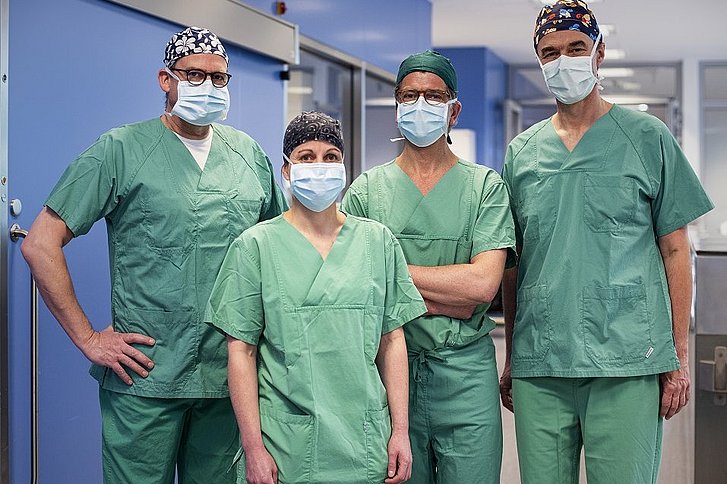Four surgical arms for maximum precision
COVID-19 –> information and vaccination centre

What sounds like a science fiction movie is in reality state-of-the-art technology in the field of operative cancer therapy and minimally invasive surgery - for the benefit of our patients.
We use the Da Vinci Xi System in visceral surgery, urology and gynaecology. It enables very complex interventions and cancer operations, which previously required open surgery, to be performed using keyhole technology. At the same time, minimally invasive procedures can be performed even more gently and precisely.
The Da Vinci Xi System is currently the most modern robotic system in the field of minimally invasive surgery. The instruments are inserted into the patient's abdomen via the smallest access points. The surgeon sits at a console with video screen and controls the instruments via finger-guided hand sensors.
The system converts the movements of the surgeon into the finest movements. This happens in real time, i.e. the system does not perform any independent movements, but supports the surgeon with highly specialized technology.
Highest precision due to various levels of fineness. The movements of the surgeon are miniaturised by the system and translated into the finest movements of the instrument arms, i.e. even the smallest surgical steps can be performed in this way with unimagined precision in a minimally invasive manner.
Outstanding detailed view through 3D video transmission in HD quality. It ensures an ideal view and depth perception and gives the surgeon a greater proximity to the operating field. The high-resolution 3D camera uses a 10x magnification to detect even the smallest tumor parts, which we can remove with high precision.
Better instrumental performance through more range of motion. The instruments are significantly more mobile than conventional endoscopes and thus enable a very high degree of accuracy, even in areas that are difficult or complicated to reach with conventional surgical techniques.
Additional support through robot assistance. Unlike conventional surgery, the Da Vinci offers the surgeon a third arm. This allows the surgeon to perform even more complex movement patterns and surgical procedures that are practically impossible to achieve with previous surgical techniques.
The sum of the individual advantages of the Da Vinci Xi System allows even very complex procedures to be performed minimally invasively, with greater precision and with a more detailed view. In laparoscopic procedures, the Da Vinci ensures even simpler and more precise procedures.
Minimally invasive approach especially in old age. Studies show that patients of all ages benefit from a minimally invasive procedure. The advantages increase significantly for patients with increasing age. They range from less pain and blood loss to minimized postoperative risks and a significantly faster recovery. Older patients, in particular, require less invasive surgery due to multiple illnesses.
State-of-the-art technology in cancer surgery. In addition to the advantages of a minimally invasive procedure, robotics offers unprecedented precision. For example, when surgically removing the prostate gland in the case of prostate cancer, we focus precisely on the structures that are important for maintaining urinary incontinence and potency (sphincter-preserving method).
Priv. Doz. Dr. med. Christoph Wullstein
Chief physician of the clinic for general, visceral and minimally invasive surgery
Telefon